20.04.2006
Vitiugov The one who robbed the rain*
My cap with the jingles
It rings on every move.
Somebody said in temper:
"A whole generation is lost".
Vasilyev "Christmas".
The Russian U-20 championships took place from March 2 till March 12 in the suburbs of Cheboksary in the Volzhanka hotel. The players had full board and lodging, the organizers provided them with an excellent prize fund, which satisfied everyone. Young players had an opportunity to determine the strongest in the fair struggle. All in all, the young chessplayers, not spoilt with numerous invitations to round robin tournaments, got an opportunity of playing in a strong tournament. It is necessary to thank the Russian Chess Federation for organizing such an excellent event! The conditions were on quite a high level despite the fact that the participants were supposed to live in single rooms, but, unfortunately, they got double rooms.
I can`t keep from daydreaming: I imagine talents of Garry Kimovich or Anatoly Evgenievich caliber developing in such conditions, I see the players conducting a serious and thorough preparation for important tournaments, guided by experienced managers and coaches. A nice picture, isn`t it? Unfortunately, it opposes the reality. I would allegorically express the objective reality by next quatrain.
It is impossible to grow through the asphalt;
It was so difficult for us, flowers.
Maybe we are not the violets,
But we already have the hardening.
Shnurov "Freedom".
Muscovite Grachev turned out to be one of such rare flowers. He was very promising early in his career: he was a champion of Russia a few times, and a medalist of European and World Junior Championships. It seems to me that he won the tournament in Samara in 2002 that was the stage of the Russian Cup. After that he gave a legendary interview «I feel that I was born to be the champion». So the Muscovite even surpassed prodigious Karjakin in his plans on the chess crown. He started paying less attention to chess, entered the university and motivated it by «the necessity of support for the further life». Well, this makes his recent results even more respected. Two shares of the first place in Moscow open and in this tournament are divided by only a month. And Boris is about to make a significant leap in his approach to chess. He worked out a competent tournament strategy in Cheboksary and surprised everyone with a good and all-round preparation to the most important games. The best way to present the winner is to show some examples of his play. The following game was played in the 10th round against Geller, and decided the outcome of the tournament.
And those who got the profit,
I remember how they smiled.
They thought everything is for them -
But it seems that they were wrong.
Grebenchikov "Zabadaj".
Geller (2505) – Grachev (2510) B90
1.e4 c5 2.¤f3 d6 3.d4 cxd4 4.¤xd4 ¤f6 5.¤c3 a6 6.a4
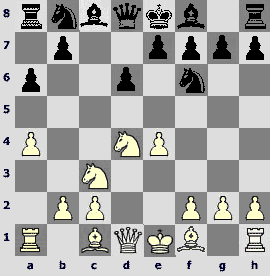
This unpretentious continuation occurs in Geller`s practice not for the first time
6...e5 7.¤f3 Јc7 8.Ґg5 ¤bd7 9.¤d2 h6 10.Ґxf6. On 10.Ґh4 Black carries out a debatable, somewhat antipositional but probably very strong idea: 10...g5 11.Ґg3 ¤c5 12.Јf3 Ґe7 13.Ґc4 Ґe6 14.a5 ¦c8 15.Ґxe6 ¤xe6 16.Јd3 ¦g8 17.f3 h5 18.Ґf2 ¤f4 19.Јf1 d5ѓ. Black developed strong initiative and proceeded to a victory (Zinchenko – Areshchenko , Rovno 2005).
10...¤xf6 11.Ґc4 Ґe6 12.Ґb3 ¦d8. Obviously, Boris picked up the idea that was realized in the game from the next example: 12...¦c8 13.a5 Ґe7 14.0–0 0–0 15.¦e1 ¦fd8 16.¤f1 Ґxb3 17.cxb3 d5 18.exd5 Ґb4 19.¤e3 Ґxc3 20.bxc3 Јxc3і Leks – Trichkov, Prague 2006.
13.¤f1
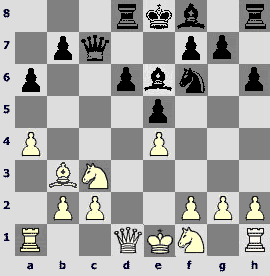
This move was followed by a draw offer. After the game Geller admitted that he missed Black`s fourteenth move. The sacrifice of the pawn is not obvious but Black`s position would be clearly worse without it. You can`t read a book by its cover. It is even more so when you speak about games. Boris resisted the temptation and continued making moves heroically.
13...Ґxb3 14.cxb3 d5!!
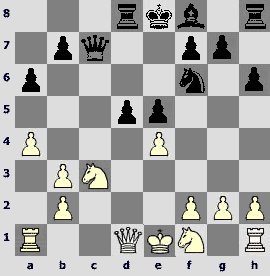
Colossal! Black makes his way in the center using the fact that White`s knight can`t make off at one go.
15.exd5 Ґb4 16.¤e3 Ґxc3+ 17.bxc3 Јxc3+ 18.ўe2 Јb2+ 19.Јd2 Јxd2+ 20.ўxd2 ¤xd5µ

Having overplayed his opponent on nuances, Black there and then got the position with a big advantage. It is very important that he wasted less than a half of his time limit. I suggest observing how easy and skillfully Grachev incarnates the extra pawn.
21.¤xd5 ¦xd5+ 22.ўe2 ўe7 23.¦hc1 ¦hd8 24.¦a2 ¦8d7 25.¦c3 ўe6 26.h4 ¦d4 27.g3 ¦b4 28.¦ac2 h5 29.¦e3 ¦bd4 30.¦ec3

At that moment I approached the table and thought by the face of Geller that the game is definitely drawn. It expressed so much tiredness and calmness at the same time. But I got to understand that Black had an extra pawn in several minutes. The endgame has never been the strongest part of the author. That`s why I decided that in spite of the shortage of the material Yasha Geller knew the right way to the convenient result. In fact, the game continued for about thirty minutes and ended by the victory of the further winner. Sad Yasha consoled himself later by a thought that he could not avoid losing one of the last three games.
30...g6 31.¦e3 ¦7d6 32.¦c8 ¦d2+ 33.ўe1 ¦d1+ 34.ўe2 ¦6d2+ 35.ўf3 ¦f1 36.¦e2 ¦xe2 37.ўxe2 ¦b1 38.¦c3 ¦b2+ 39.ўe3 f5 40.¦d3 a5 41.¦c3 e4 42.f3 ўd5 43.fxe4+ fxe4 44.ўf4 ¦f2+

0–1. Geller lost only one game as White in the whole tournament. Probably, you have already guessed which game it was. Grachev`s preparation worked splendidly.
The Muscovite lost only once in the tournament, while the others had two and more losses. He defeated Tomashevsky, who was the rating favorite, in their 9th round encounter. Grachev tried to play tightly for the whole tournament. A funny game against the author can serve as an example of such tight play.
Grachev (2510) – Vitiugov (2573) D31
Having played this game, I felt myself to be a player of the elite round robin tournament. To tell the truth, we are not worse because we repeated the well-known theory, made several original moves, shook hands, analyzed a bit after the game and decided that White doesn`t have any advantage.
1.d4 d5 2.c4 e6 3.¤c3 c6 4.e4 dxe4 5.¤xe4 Ґb4+ 6.Ґd2 Јxd4 7.Ґxb4 Јxe4+ 8.Ґe2 ¤a6 9.Ґd6 e5 10.¤f3 Ґg4 11.0–0 0–0–0 12.Ґd3 Јf4 13.Ґxe5 Јxe5 14.¤xe5 Ґxd1
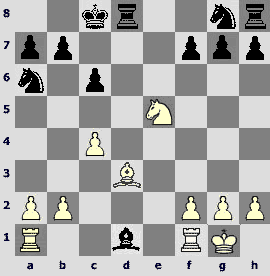
However, there was one interesting moment in this game. The day before Aronian triumphed in the game against Vallejo in his usual magical style. He caught his opponent on the ignorance of the game Tal – Dorfman.
15.¦axd1. The winner of the World Cup gave check in this position, following Tal – 15.Ґf5+ ўc7 16.¤xf7. The Spaniard lost in thoughts for about forty minutes and made a mistake. Either he didn`t remember the right move or he decided to try the other way... 16...Ґh5? (the right way is pointed by the eighth world champion in his commentaries to the notorious game:16...¤h6! 17.¤xh6 Ґh5! 18.Ґg4 Ґg6=) 17.¤xd8 ўxd8 18.g4 ¤h6 19.¦ad1+ ўc7 20.¦d7+ ўb6 21.¦xg7 ¤xf5 22.gxf5 ¦f8 23.¦e1 ¤c5 24.b4 ¤d3 25.¦ee7 ¤xb4 26.¦xb7+ ўc5 27.¦g5ќ Aronian– Vallejo, Linares 2006.
15...¤h6. Both Black`s knights got to the fringe of the board and now he has nothing to worry about.
16.Ґc2 g6 17.¤f3 ¦he8 18.¦xd8+ Ѕ–Ѕ
In my opinion, it is time for self-promotion. I have the right to boast because I not only took the first place but also decided to write this article. In spite of being the second number of the seeding I consider this result to be a great success. All the games were ragged that became apparent strikingly in decisive games. I managed to get +3 exceptionally with the help of my moral qualities. The game against Nepomniachtchi happened to be of more or less decent quality.
Vitiugov (2573) – Nepomniachtchi (2506) A57
Thegamewasplayedinthetenthround. At that moment Ian was the leader of the tournament having +3. The author had to be engaged with shy +1 after the defeat to Lysyi in the previous round. In general, it was necessary to win without fail. As a matter of fact, it was almost the situation of the second game of a knock-out when Ian could be satisfied with a draw.
1.d4 ¤f6 2.c4 c5. Surprise. My opponent usually plays the Grünfeld defense. 3.d5 b5 4.cxb5 a6 5.e3
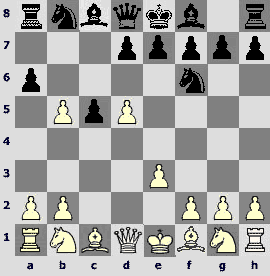
It is cowardice and ruse at once. It is known that White has a definite advantage in main variations but... In general, White chooses not the most pretentious continuation, following the game Moiseenko – Khairullin, 2005.
5...axb5 6.Ґxb5 Јa5+. Has White really blundered the bishop? 7.¤c3. No, he didn`t... yet. 7...Ґb7 8.Ґd2 Јb6 9.Ґc4 e6 10.e4 ¤xe4 11.dxe6 dxe6 12.¤xe4 Ґxe4 13.¤f3. I wasted about forty minutesby this point. Later Ian said that it was a known theory.
13...¤c6 14.Ґc3 Ґe7 15.0–0 0–0
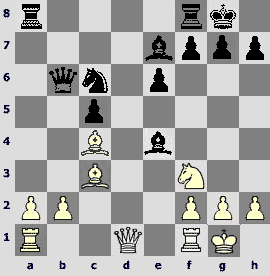
White's structure is better and Black doesn`t have clear objects to attack. On the whole, I managed to get quite a good position but it seems to be without any clear advantage. The struggle takes a completely different character after daring 15...Ґf6!?
16.Јe2 Ґxf3?! I think that White`s position is better after this move though it isn`t won. White had an interesting trick 17.¤e5!? in response to the natural 16...Ґd5, and after 17...¤xe5 18.Ґxd5 exd5 19.Јxe5 d4 20.Јxe7 ¦fe8 21.Јg5 dxc3 22.bxc3 he could have won a pawn. Probably it was worth to play 16...Ґg6!?, but the g6-bishop would not be really useful in this case.
17.Јxf3 ¤d4 18.Јd1!І. It is not good to boast but this move looks to be very strong. Black starts to trouble White`s pieces and pawns on 18.Јe4 by 18...¦a4 19.b3 ¦a3!? It is not easy to defend the a2-pawn now.
18...¦fd8. Probably it was better to play 18...¤b5!? 19.Ґxb5 Јxb5 20.Јg4 g6 21.a4І, but in this variation White`s position is also better.
19.a4
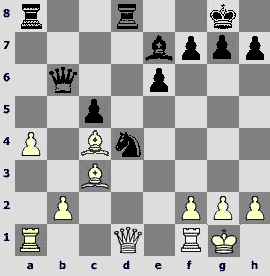
Having moved the passed pawn forward, the author turned down a draw offer. The knight`s bounces are not dangerous.
19...Јb8. Black strives for the activity. It is impossible to stay still.
20.Јg4. On 20.a5the Black`s queen could jump near the White`s king – 20...Јf4.
20...ўh8 21.a5 f5 22.Јh3 e5. The Black`s center is beautiful but shaky. I think it is even unstable. However, it wasn`t worth to make it wobbly immediately.
23.Ґxd4? A grave error produced by the shortage of time. I wanted to simplify the position. It was really stronger to play 23.b3!? (or any other move that increased the pressure on the queenside) 23...g6 24.a6±. Black`s position is difficult and the a6-pawn is very dangerous but White has not much time and confidence...
23...¦xd4 24.Јxf5 ¦xc4 25.Јe6 ¦c2 26.Јxe7 h6!= Strong preventive measures. Black makes a luft that is very important in such positions without determining the piece to take on b2.
27.¦ad1. Obviously, this practical decision is not the strongest. White is ready to get a position "three pawns against two pawns" in order not to overstep the time limit. However, there is no advantage in this position. 27.b3!? Јxb3 28.Јxe5 ¦a2 (28...Јc4!?) 29.Јxc5 Јa4 30.¦xa2 Јxa2 31.¦e1 ¦xa5=; the move by the other rook on d1 is more logical but it seems to me that it doesn`t give any advantage: 27.¦fd1 Јf8 (27...Јxb2!? 28.¦ab1 Јa2 29.¦b7 ¦g8=).
27...Јe8? Black makes a serious mistake a step of the draw. Why he did not play 27...¦xb2™ 28.¦d7 Јf8 29.Јxe5 ¦a2? If White continues 30.¦d6, Black simply plays 30...ўh7 31.f4 (an attempt to open the position of Black`s king doesn`t work: 31.Јxc5!? ¦2xa5 32.Јc2+І – three against two, objectively the position is drawn) 31...¦8xa5 32.f5 ¦a6 33.¦e6 Јf7=.
28.Јb7І
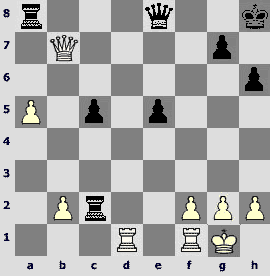
Ofcourse! White`s queen takes up almost the best square.
28...Јc8. Black couldgo back on his word but after 28...Јb8 29.Јe4 ¦xb2 30.¦d7 he already has an inferior position: 30...¦a7 (30...¦xa5 31.¦fd1 ¦a8 32.¦xg7!ќ) 31.¦xa7 Јxa7 32.Јxe5 ¦a2?! 33.¦b1!±. And 28...¦xa5? loses at once after 29.¦d7ќ.
29.Јb3. Apparently, Black overlooked this resource. The clumsy location of the rook on c2 tells.
29...Јf5 30.¦a1?! An illiterate move. White doesn`t need to withdraw his rook from the active position. 30.h3!?± would have been a demonstration of deep insight.
30...¦a6 31.¦ae1 (White hopes to take on e5) 31...¦f6
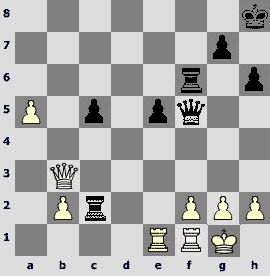
I decided that Ian just got tired and he didn`t see a primitive blow on e5 in this position. I prepared, braced myself and... noted a trap! I could have really fallen into it!
32.Јe3. White had about two minutes. That`s why he decided to make tighter move in order not to blunder the mate. 32.¦xe5?? Јxf2+!°.
32...¦a6 33.Јb3 ¦f6 34.Јe3 ¦a6. It was possible to pass to the rook ending after 34...¦xb2 35.Јxc5 e4 36.Јxf5 ¦xf5 37.¦a1, but it is very hard if not impossible to hold it. For example, 37...¦b7 38.a6 ¦a7 39.¦a2ќ. White doubles his rooks along the a-file, brings the king, and the game is decided.
35.¦a1 e4. Another crafty trap. Black complicates White`s time trouble life.
36.b3 (White could be caught by 36.Јb3 e3 37.fxe3 ¦xg2+!) 36...Јe5 37.¦a4

I liked the White`s position a lot (not without reasons). However, it seems that White only has a small advantage, and the position isn`t won, contrary to what I thought during that game.
37...¦c3? A decisiveerror. It was impossible to improve something later on. The queen`s jump on c3 was clearly stronger: 37...Јc3 38.Јxe4 Јxb3 39.h3!?І White has an advantage but Black can sting the draw. Logical play against the king doesn`t work: 39.Јe8+ ўh7 40.¦f4 Јe6 41.Јb5 Јe2!= 42.Јb1?! ¦xa5.
38.Јe2 Јd6 39.¦xe4 Јd3 (39...¦xb3 40.¦e8+ ўh7 41.Јc4!ќ doesn`t change anything) 40.Јg4 ¦xa5 41.¦e7 (an immediate check 41.Јc8+!?ќ was also interesting) 41...Јd4 42.Јc8+ ўh7 43.Јf5+ 1–0
I promised to tell specially about Nepomniachtchi. He was the leader of the tournament for the most part of it. However, Ian gathered only half a point in the last two rounds (the author of these lines is also guilty of it) and he couldn`t catch on the place in the Higher league because of the poor tiebreak score. I hope that the leadership of RCF (or the Council of trainers) will take into account Ian`s services on the numerous junior tournaments and will make a decision to allow Nepomniachtchi to the semi-final of the Russian Championship. Otherwise, a rare talent can be wasted: in 11 rounds Ian "overtook" no less than three points! He defeated his opponents and not only them by his reckless and lucky play and sparkling optimism.
Nepomniachtchi (2506) – Geller (2505) B41
I note at once that the author didn`t comment this game. I only edited Ian`s notes. So, then this game is commented by the talented chessplayer from Bryansk, the world U16 vice-champion of 2005, the European champion of 2001, the member of "Tomsk-400 YUKOS" team – all in one, Ian Nepomniachtchi.
1.e4 c5 2.¤f3 e6 3.d4 cxd4 4.¤xd4 a6?! Nepomniachtchi : Black certainly knows better what variation he likes to play but I didn`t find straight refutation of the move 4...¤c6 neither before the game nor after it. Yakov makes this move very often and gains stable share of points in this variation. However, it is always very tempting to confuse the opponent`s opening prep. Vitiugov : As a great fan of the Paulsen variation I can`t agree with Ian`s appraisal. In my opinion, the moves ¤с6 and а6 are equitable. It`s quite another matter that Yakov doesn`t have experience in one of these continuations.
5.Ґd3 Јc7 6.c4 ¤f6 7.¤c3 Ґe7?! To my mind, this move is passive and absolutely unpretentious, which seems to be a logical continuation of 4...a6. It is really more naturally to play 7...¤c6! 8.¤xc6 dxc6 9.0–0 e5,and the game is equal.
8.0–0 0–0 9.Ґe3 d6 10.f4 ¤bd7
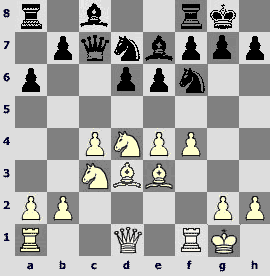
11.g4!ѓ. The theory recommends including corroborative 11.¦c1 b6 12.b4 Ґb7. Now after 13.g4 it is very difficult for Black to find satisfactory arrangement of his pieces. (Vitiugov: I will modestly note that White`s pawns are placed not in the most solid way). For example, 13...ўh8 14.g5 ¤g8 15.¦f3!? (15.f5 exf5 16.¤xf5±) 15...e5 16.¦h3! g6™ (16...exd4? 17.Ґxd4 f6 (17...¤e5 18.fxe5 dxe5 19.¤d5ќ) 18.¤d5! Ґxd5 19.Јh5! h6 20.exd5ќ) 17.¤d5±. It seems to me that the early pawns advance provides White with a stable positional and psychological advantage. Anyway, we are given the impression that Black played the part of the game without believing in his position.
11...¤c5 12.g5!?N. It is interesting that White always played 12.Ґc2 before, allowing 12...e5! (12...Јb6?! 13.g5 ¤e8 (13...Јxb2 14.gxf6 Јxc3 15.fxe7 Јxe3+ 16.ўg2 ¦e8 17.¦f3ќ) 14.¤b3±; 12...d5?! 13.exd5! exd5 14.g5 ¤g4 15.¤xd5 ¤xe3 16.Ґxh7+!ќ Macieja – Gratka, Poland 1997) 13.¤f5 Ґxf5 14.exf5 exf4 15.¦xf4 (15.Ґxf4 Јb6„) 15...h6, Black manages to stabilize the game. Extreme accuracy is required from him in this position (15...d5!? 16.g5 Ґd6 17.Јc1!±).
12...¤xd3!? An interesting practical chance. Geller managed to repulse the first attack and to consolidate his forces at the cost of a piece. White has an overwhelming advantage in the variation 12...¤g4 13.Јxg4 ¤xd3 14.Јe2 ¤b4 (14...¤c5 15.f5 Јd8!? (15...exf5 16.exf5 Јd8 (16...¦e8 17.¤d5 Јd8 18.Јh5ќ) 17.Јh5ќ) 16.b4 ¤d7 17.fxe6 ¤e5 18.exf7+ ¦xf7 19.¦xf7 ¤xf7 20.h4ќ) 15.f5 ¤c6 16.f6 Ґd8 17.¤xc6 Јxc6 18.fxg7 ўxg7 19.Јh5. And after 12...¤fd7 13.Ґe2

Black`s position turns out to be so durable that it isn`t easy for him to find a useful move.
13.gxf6. Simple 13.Јxd3 ¤d7 (13...¤g4? 14.Ґd2 Јb6 15.ўg2ќ) 14.¦ad1 leads to a stable advantage, but a wish to punish the impudent knight was too strong... Vitiugov: Probably, Ian went too far. Black`s position is quite playable, and is just excellent compared to the one in the game! Fortunately, White does not need to go for it.
13...¤xb2 14.Јe2. 14.fxe7?! is too creative: 14...¤xd1 15.exf8Ј+ ўxf8 16.¦fxd1 b5!І, and White`s advantage is not big enough.
14...Ґxf6 15.Јxb2 Јxc4. Black must take the c4-pawn. Otherwise it is unclear why Black`s valiant knight was sacrificed.
16.¦fd1 Јc5?Asthe saying goes, Black doesn`t look for easy ways. Obviously, it is very optimistic to play 16...e5?! 17.¤d5! exd4 18.¤xf6+ gxf6 19.Јg2+ ўh8 20.Ґxd4 Јxd4+™ (20...Јe6? 21.f5 Јe7 22.Јh3 ¦g8+ 23.ўf2, and it is time for Black to give up because after Јh4 or Јh6 he cannot defend the f6-pawn) 21.¦xd4 ¦g8 22.¦xd6, White wins easily. That`s why a modest 16...Јc7 is the best chance, however, after 17.¦ac1 Јe7 (17...Јa5 18.¤b3 Јb4 19.Ґd4ќ) 18.¤f3 followed by e4-e5 Black`s position can hardly be called promising.
17.e5!
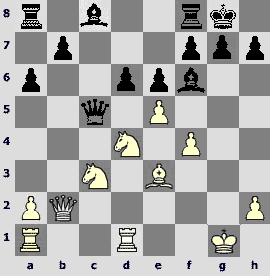
It is rare when a beautiful move turns out to be the most effective. The second knight settles down to the game and finally White`s lead in the development has its effect.
17...dxe5 18.¤e4 Јe7! This is probably the only move, but it is always nice to see the opponent playing creatively as well as you do. 18...Јd5 19.Јg2! ўh8 20.¤b3 Јb5 21.Ґc5 ¦e8 22.¤xf6 gxf6 23.¦d8!! leads to a more prosaic end.
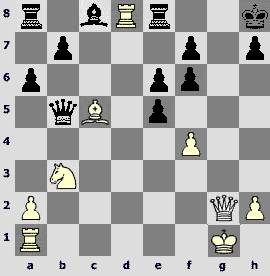
23...Јxc5+ (23...¦xd8 24.Ґe7ќ) 24.¤xc5 ¦xd8 25.ўh1!?ќ.
19.¤c6! bxc6 20.Ґc5 Јe8. Probably it was worth to sacrifice a queen, as usual: 20...exf4 21.Јa3 Јxc5+ 22.Јxc5 Ґxa1 23.¦xa1 f6 24.Јxc6 ¦b8. However, it is still difficult to make a draw in this position. Vitiugov: I will explain it to the reader. Geller likes to play positions with imbalanced material. He often gets rid of the queen. The game against me in this tournament provides a good example.
21.¤xf6+ gxf6 22.Јa3! The most accurate, although in this position virtually any sensible move leads to a victory, for instance, 22.Јb6 Ґd7 23.Ґxf8 ўxf8 24.Јc7 ¦d8 25.¦d2! Јe7 26.¦ad1 ўe8 27.¦g2 Јf8 28.fxe5 fxe5 29.Јxe5ќ, or 22.ўh1 ўh8 23.Ґxf8 Јxf8 24.fxe5 a5 25.exf6ќ.
22...Ґb7. Black`s position is tough. 22...ўg7 23.ўf2 ¦g8 24.¦g1+ ўh8 25.¦xg8+ Јxg8 26.Ґe7 Јg6 27.Ґxf6+!ќ doesn`t save.
23.ўf2 h6 24.¦ab1
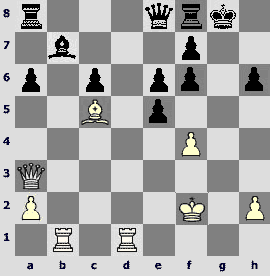
A complete domination. To my mind, playing without extra pawns would have been easier for Black...
24...¦d8 25.Ґxf8 Јxf8 26.Јxf8+ ¦xf8 27.¦xb7 exf4 28.¦g1+ ўh7 29.ўf3 e5 30.ўe4! The centralization of the king is important even in endgames with three rooks. Black gave up. 1–0
Nepomniachtchi (2506) – Savchenko (2569) B77
Ian comments as usual.
1.e4 c5 2.¤f3 ¤c6 3.d4 cxd4 4.¤xd4 g6 5.¤c3 Ґg7 6.Ґe3 ¤f6 7.Ґc4 0–0 8.Ґb3 d6 9.f3 Ґd7 10.Јd2 ¤xd4 11.Ґxd4 b5 12.h4 a5 13.h5 e6!?
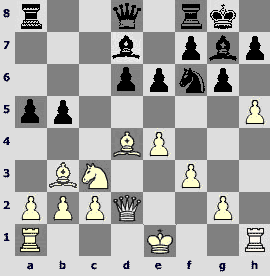
Perhaps this move is the least studied in this topical position. Black plays 13...e5 or 13...a4 more often.
14.a4! White suppresses the opponent`s counterplay on the queenside. 14.hxg6!? a4 15.gxh7+ ўh8 16.Ґd5 exd5 17.0–0–0!ѓled to complications.
14...bxa4. Black`s position is miserable after 14...b4?! 15.¤e2±.
15.¤xa4. Undoubtedly, 15.Ґxa4 Ґxa4 16.¦xa4 gives the advantage but I would prefer to save two bishops. Attackwithboth of them somehow feels nicer.
15...¦b8. 15...Ґxa4!? 16.Ґxa4 (16.h6 Ґxb3 17.hxg7 ¦e8 18.Јh6 e5 19.Ґe3 Јc8! 20.cxb3 Јc2›) 16...¤xh5 17.Ґxg7 ¤xg7 18.Јh6 ¤h5 19.g4 ¤f6 deserves attention, as it looks like Black holds.
16.hxg6 hxg6 17.Ґe3!? Sensible and according to the plan. Although, perhaps it was worth trying to play 17.Ґc3 Јe7 18.Ґxa5 Ґc6 (18...d5 19.e5 ¤e8 20.f4 f6 21.¤b6ќ) 19.g4±.
17...Ґxa4 18.¦xa4 ¦b5 19.g4
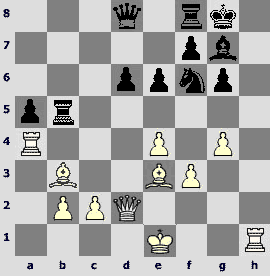
Trouble is brewing for Black`s king. I thought my position to be won easily. White only has to play Јh2 and checkmate the opponent. Boris finds the only resort.
19...d5! I don`t see much sense in discussing alternatives here. Black can keep in the game only if he confuses the issue cleverly.
20.e5 ¤d7 21.Јh2 f6 22.f4!? Suddenly White`s position became very uncomfortable. Unfortunately, there is no mate. Black is better prepared for opening the center and he threatens to seize the initiative. 22.exf6 ¤xf6 leads to an unclear position, and principled 22.Јh7+ ўf7 23.Ґh6 ¦g8 only brings problems to White.
22...ўf7 23.Јe2 Јb8„ 24.f5! It is necessary to destroy the Black`s king`s shelter, or Black`s position will be better. The long-term advantages are on his side. Moreover, it is the only way to enliven the White`s bishops.
24...¤xe5. The knight is very well placed in the center. Other captures were weaker, even if only according to general considerations.
25.fxe6+ ўxe6 26.¦h7 ¦f7 27.Ґa2!?
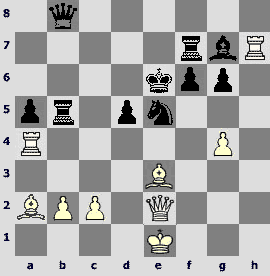
The mark is given for the creative approach rather than objective strength of the move. Probably it was necessary to play 27.Ґd2 Ґf8 28.¦h3, and the game is quite even. Now Black creates very dangerous threats.
27...¦e7 28.¦d4 ўf7! The Black`s king has time to run off. After 28...Јb7 29.g5! Black faced grave difficulties.
29.¦xd5 ¦xd5 30.Ґxd5+ ўe8 31.c3 Јd6. Boris fortifies his position in time. Striving for the material is dangerous: 31...Јxb2? 32.Јxb2 ¤d3+ 33.ўd2 ¤xb2 34.Ґd4, and it looks as if it is time for Black to rest on his oars. Black`s pieces are too poorly placed, and the material losses are unavoidable.
32.Јb5+ ўf8 33.ўd2 ¤xg4
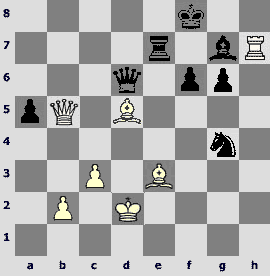
34.Јc5!? A small provocation. White could achieve a draw by a "calm" 34.Ґd4 Јf4+ (34...Ґh6+!? 35.ўd3! Ґe3 36.¦xe7 (36.¦h8+) 36...Јxe7 37.Јb8+ ўg7 38.Јg8+ ўh6 39.Ґf7 ўg5™ 40.Јxg6+ ўf4›) 35.ўc2 ¤e3+ 36.Ґxe3 Јxe3 37.Јxa5. Now the opponent certainly wishes to gain the wanted point...
34...Јc7?! (it was necessary to play 34...Јb8! 35.¦xg7 Јxb2+ 36.ўd3 Јb1+ 37.ўd2 Јb2+=) 35.Ґd4 Јf4+ 36.ўd3 ¤e5+?! Not a good idea. After 36...Јg3+ 37.ўc2 ¤e3+ 38.ўb3 ¤xd5 39.Јxd5 Јb8+ 40.ўa2 Јb7 the game is even again.
37.ўc2 Јf5+ 38.ўb3 ¤d3? Black`s position is not sweet but he did not need to blunder. However, Black already has real problems with sensible moves even after 38...a4+39.ўa2 Јd7 40.c4.

39.Јb5? The false step in return. 39.Јd6! Јd7 40.¦xg7!ќwould have won immediately.
39...Јd7 40.Јxa5 Јe8. Boris decided to strengthen properly with his 40th move. It is very difficult to blame him for it such as there are no active alternatives.
41.Јb6 ¤f4 42.¦xg7?! Having wasted much time for calculating, I chose the continuation that wasn`t the best. Both 42.Ґc4 ¤e6 43.Ґe3± and 42.Ґc6 Јf7+ 43.c4 ўg8 44.¦h1±keep a huge plus for White.
42...¤xd5 43.¦xe7 ўxe7 (43...Јxe7?! 44.Јc6 Јe4 45.Ґxf6± led to a loss of a pawn) 44.Ґc5+ ўf7 45.Јb7+
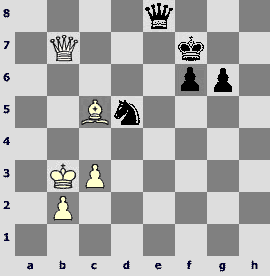
45...ўe6?? A blunder. A cool-blooded 45...¤e7 would keep some drawing chances, although after 46.ўa3 g5 47.b4 Black would have to sweat to bite off the precious half a point.
46.c4 Јd8 (46...¤e7 47.Ґxe7 Јxe7 48.Јd5#!) 47.cxd5+ Јxd5+ 48.Јxd5+ ўxd5 49.Ґe7. The rest of the game does not require any commentary. 49...f5 50.ўc3 f4 51.ўd3 ўe6 52.Ґd8 ўd5 53.b4 ўc6 54.ўc4. Black resigned. 1–0
Boris Savchenko, who surpassed Ian on tiebreak but he was inferior to Evgeny Tomashevsky in the tie for the 3rd place, is quite an original player. His creates positions that are difficult to assess and achieves good results in them, which is of course the most important part for a chess pro. Despite the fact that several aspects of his play offend the eyes (for example, unsatisfactory handling of black pieces), his general approach seems to be very creative. It is so rare nowadays!
In my opinion, the game Khairullin-Tomashevsky is the most interesting and tense game of the tournament. It was played in the sixth round between two main favorites of the tournament. To be honest, at that moment they both had only fifty per cent score. The loser would have to abandon any title hopes. A draw could save senseless status quo. The winner could not only take a very important point but also get rid of a dangerous competitor.
Khairullin (2533) – Tomashevsky (2586) C84
I am ready to present the players. Ildar Khairullin is U14 world champion and U18 world champion. He is also a leader of the shock generation of 1990. He is a member of the FINEC chess team in the Russian Premier league. Ildar is aggressive, has a vigorous nervous system. In general, he is an excellent guy. Knock-out wins and decision wins are equally distributed throughout his boxing... um, his chess career. Evgeny Tomashevsky is a participant of the Russian Superfinal of 2005 and U18 vice-world champion of 2004. He is a leader of the generation of 1986-87. He plays for the team Economist-SGSEU in the Russian Premier league. Evgeny is strong; he reads the play perfectly. On the whole, he is a bright mind. Usually wins by decision.
1.e4 e5 2.¤f3 ¤c6 3.Ґb5 a6 4.Ґa4 ¤f6 5.0–0 b5 6.Ґb3 Ґb7 7.d3 Ґe7 8.¤c3 0–0 9.Ґd2 d6 10.¤e2!?N
diagramma
A novelty aimed at a lengthy struggle without any claims of refuting Black`s opening strategy immediately. Ildar tried more unpretentious 10.¤d5 in this position a month ago. 10...¤xd5 11.Ґxd5 ¦b8 12.c3 Ґf6 13.a4 ¤e7 14.Ґxb7 ¦xb7 15.axb5 axb5 16.d4 ¤g6 17.Ґe3 b4 18.d5 bxc3 19.bxc3 ¤h4 20.¤xh4 Ґxh4 21.¦b1 ¦xb1 22.Јxb1 Ґg5 23.Ґxg5 Јxg5 24.Јb7 Јd8 25.¦a1 Ѕ–Ѕ Khairullin – Khalifman, Moscow 2006.
10...¤d7. Evidently, this reaction is not the most successful. 10...d5!?; 10...Ґc8!?
11.¤g3 ¤c5 12.Ґd5 ¦b8. This move seems to be reasonable but apparently it is one of the reasons of Black`s future difficulties. 12...Ґf6!?
13.b4 ¤e6 14.c3!І
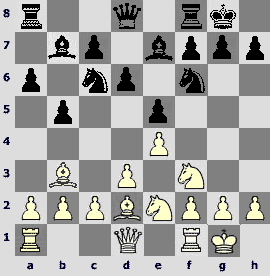
This move is simple and strong. White wants to play Ґe3 and d4. It is difficult to say now what Black can oppose to this plan. It is the type of І that uses to turn into ± in no time.
14...Ґf6 (14...Јd7?! 15.Ґe3 Ґf6 16.¤h5!± (16.d4 exd4 17.cxd4 ¤xb4 18.Ґxb7 ¦xb7 19.a3 ¤c6 20.d5 (20.e5!? dxe5 21.d5) 20...Ґxa1 21.Јxa1ѓ is weaker)) 15.¤h5 ¤a7. Black`s knight gradually moves from c6 to a4. It is obvious that Black`s position is difficult already.
16.Ґe3. A logical move, White prepares d3-d4. At the same time he had another idea that was a bit doubtful from the strategic point of view: 16.Јb3!?, with the idea of meeting 16...¦e8 by 17.Ґxb7 ¦xb7 18.Јa3±, winning a pawn.
16...¤c8 17.d4 exd4. Black couldn`t maintain the tension: 17...¦e8?! 18.Ґxb7 ¦xb7 19.d5 ¤f4 20.¤xf6+ Јxf6 21.g3±, and all Black`s difficulties are ahead. There was an alternative, though a very unpretentious one: 18.dxe5 dxe5 19.Ґxb7 (19.Ґxe6?! Јxd1 (19...fxe6? 20.¤d2±) 20.¦axd1 ¦xe6=; 19.a4!?) 19...Јxd1 (19...¦xb7 20.Јd5ѓ) 20.¦fxd1 ¦xb7 21.¤xf6+ gxf6 22.¤h4І.
Of course, 17...Јe7? 18.Ґxb7 ¦xb7 19.d5 ¤d8 20.¤d2± is even weaker – Black will have to resign soon.
18.cxd4 ¦e8 19.Ґxb7 ¦xb7
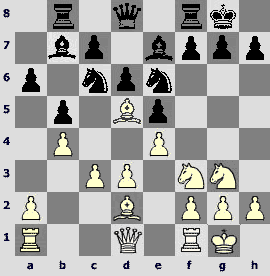
White`s pieces are placed very well. He has an excellent center. So it is time to turn potential energy into a kinetic.
20.Јc2? This move based on general considerations is unusual for Ildar. Much more energetic and strong is 20.d5 ¤f8 21.¤d4! Probably Ildar didn`t see this maneuver. Black`s position represents a pitiful sight after it. 21...Ґxd4 (21...¦xe4 22.¤c6 Јd7 23.¤xf6+ gxf6 24.Јd3! (24.Јf3‚) 24...f5 25.Јa3, and White stands slightly better) 22.Ґxd4 f6 23.Јg4 ¤g6 24.f4,

and if someone holds this position against Ildar, I`ll gladly shake hands with that brave person. For example, 24...¦xe4 25.Ґxf6! gxf6 26.¤xf6+ Јxf6 27.Јxc8+, and White has a decisive advantage.
20...¤b6. Black`s knight went off the eighth rank – a relief at last! Still, White retains an advantage.
21.¤xf6+. After 21.e5?! Ґe7 22.Јe4 (22.Јc6!?) 22...d5 23.Јg4 White`s position is rather risky.
21...Јxf6 22.d5 ¤f4 23.¤d2 (23.Ґxf4 Јxf4 24.¦fe1І was too vapid) 23...¤a4 24.¦ae1 ¦bb8 25.g3 ¤g6

26.¦c1?! A sluggish move. The position is not so closed to move but-and-ben with impunity. 26.f4!? is more active: 26...Јc3!? (26...¦bc8? 27.e5! Јd8 (27...dxe5 28.f5 ¤f8 29.¤e4ѓ) 28.e6 fxe6 29.dxe6±) 27.Јb3!? (27.Јxc3?! ¤xc3 28.Ґd4 ¤xa2 29.¦b1 ¤e7! 30.¦b2 ¤xb4 31.¦xb4 c5 32.dxc6 ¤xc6 33.Ґc3 ¤xb4 34.Ґxb4›). And 26.Јxc7!? is even more interesting with a sample variation 26...¤c3 27.f3 ¤xa2 28.Јa5 ¤c3 29.¤b3 ¤e5 30.Ґd4 ¤xd5 31.exd5 ¤xf3+ 32.ўh1 Јf5 33.¦xe8+ ¦xe8 34.¤d2 Јd3 35.Јc7І.
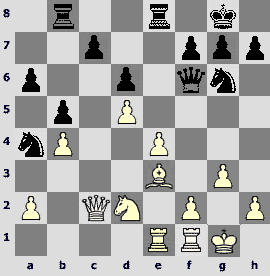
26...¦bc8 27.f4 ¤e7 28.Јd3 c6 29.Ґd4 Јh6 30.f5. Gambling in view of a mutual time trouble. After 30.dxc6 thegameiseven.
30...cxd5 31.¦xc8 ¦xc8 32.f6 ¤c6 33.exd5. A tempting pin does not yield anything good: 33.¦c1 dxe4! (33...Јh3!?„) 34.Јxe4 ¤c5 35.bxc5 Јxd2 36.Ґe3 d5!і.
33...¤xd4 34.Јxd4 ¤c3

35.Јg4?“. This move disrupts the balance. It was more logical and strong to play 35.ўg2 Јh5 (if 35...¤xa2, then after 36.Јg4 ¦d8 37.Јd4 Black doesn`t have anything better than 37...¦c8= (37...¦e8?! 38.¤e4ѓ)) 36.¦c1 Јe2+ 37.ўg1 (37.ўh1 ¦c4! 38.¦xc3 Јe1+=) 37...Јe8 38.¦xc3 Јe1+=. It was also possible to play 35.ўh1!? with the same ideas.
35...¦e8!µ 36.Јd7 Јe3+ 37.ўh1 ¤xd5
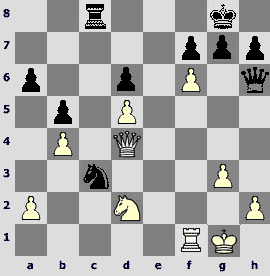
I remember correctly, at this moment I stepped to the table. Each of the opponents had about two minutes left. There were dashing dances in the other room. A popular melody "Chita-Drita" was heard even in the tournament hall. What can I say now? It is a real heroism not to overstep the time limit in such situation! It is much tougher than Botvinnik`s training games with the radio turned on.
38.fxg7 Јe6 39.Јa7 ¤e3?! A plain pawn capture 39...¤xb4!? was simpler and stronger.
40.¦f3™ Јd5 41.Јd7 Јe6 42.Јa7 ¤g4 43.Јd4™ Јe1+ 44.¤f1 Јe4 45.Јxe4 ¦xe4
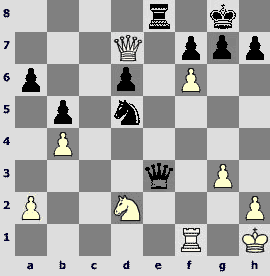
How should we assess this endgame? It is clear that it is practically hopeless for White taking into account the previous course of the struggle. It is well known that Tomashevsky is the best endgame player among young Russian chessplayers. However, White still has certain chance. For instance, there is an interesting idea associated with the knight transfer to f5.
46.¦a3 ¦xb4 47.¦xa6 ¦b2 48.¦xd6 ¦xa2 49.¦d4 ¦a4 50.¦d5 ¦b4 51.h3 ¤f6 52.¦f5 ўxg7°
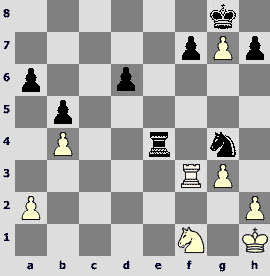
This position is completely hopeless. It isn`t necessary to comment the rest of the game. So I will give only one diagram.
53.ўg2 ¦b3 54.g4 ¤e4 55.¦e5 ¤d6 56.¤g3 ўf6 57.¦h5 b4 58.¦xh7 ¦d3 59.¦h8 b3 60.¦b8 ўe5 61.¤e2 ¦d2 62.ўf2 b2 63.ўe1 ¤c4 64.¦b5+ ўe4 65.¦b4 ўe3 66.¤c3

66...¦c2 (66...ўd3! 67.¦xc4 ¦e2+ 68.¤xe2 ўxc4°) 67.¤d1+ ўd3 68.¦b3+ ўd4 69.¤xb2 ¤xb2 70.¦f3 ¤d3+ 71.ўf1 ¤e5 72.¦f2 ¦c3 73.ўg2 ўe4 74.¦f5 ўd5 75.g5 ўe6 76.¦f6+ ўe7 77.h4 ¤g6 78.h5 ¦c5! 0–1
The author became slightly overenthusiastic talking about the level of this championship. The event remains to be junior anyway. The ratings of young chessplayers not always confirm their real chess strength. They haven`t stabilized yet. That`s why sometimes we can see the examples of rather eccentric play.
Maletin(2538) – Savchenko (2569)
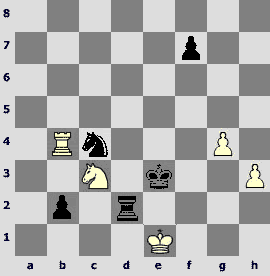
Black played 24...a5 and offered a draw, having realized that he loses after an elementary 25.¦c8. It is notable that each of the opponents had already refused a draw offer by that point. This time Pavel agreed. Be watchful!
Savchenko (2569) – Tomashevsky (2586) C45
A short prehistory. Savchenko had 2.5 points out of 3. Tomashevsky managed to collect only 1 out of 3, losing with White in the previous round. It was a very important moment for the rating favorite, and he stood it honorably.
1.e4 e5 2.¤f3 ¤c6 3.d4 exd4 4.¤xd4 Ґc5 5.¤xc6 Јf6 6.Јd2 dxc6 7.¤c3 ¤e7 8.¤a4

Probably this continuation is not the best.
8...Ґd6 9.f4 ¤g6 10.g3 Ґg4. White`s position is not hopeless but it is difficult indeed. 11.h3 Ґf3 12.Ґg2
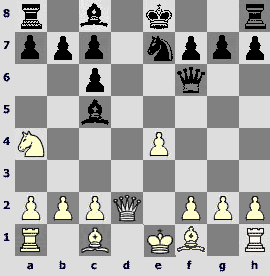
12...Ґxf4. White can well give up here. Boris made a few move irrelevant moves.
13.gxf4 ¤h4 14.ўf2 Ґxg2 15.¦d1 0–0 16.Јe3 ¦fe8 17.e5 Јg6 18.¤c3 ¤f5 19.Јd3 ¦ad8
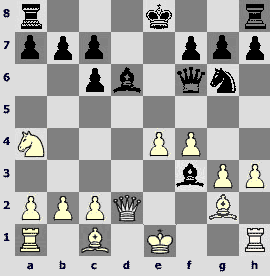
0–1. One won`t believe that Boris Savchenko is a very strong master rated above 2500. As they say, it is all of a sudden.
Maletin (2538) – Lysyi (2523)
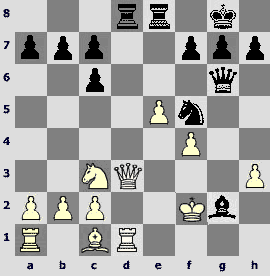
Black loses this almost equal position in five moves. Apparently, it is a black-out.
16...a5?! 17.¦ac1 Ґf6? 18.e4 ¤b4 19.a3 Јxd3?? 20.Ґe3
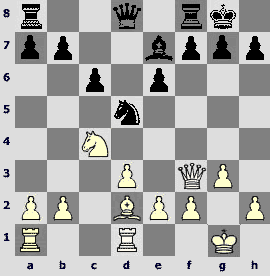
1–0
The reader has the right to cry out: "Hey, author! Why do you perfect your sense of humor on the others? Tell how you have lost your games! Tell me, how you played in first half of the tournament. Don`t put on a modest air!"
I can answer. The game against Boris Savchenko was commented in the "Chess week". I can only give the reference - #7, 2006. The other game that was lost to Igor Lysyi was worth of too many nerves. I don`t want to reopen my old wounds that have just skinned over. I will remind the meticulous reader of the fact that the games are always accessible on the Internet (although without commentaries of your obedient servant).
I think it would be great if the idea of Anatoly Avraamovich Byhovsky about awarding the most promising young players with grants that was advanced in the third issue of "64" will be realized. The help and the attention from the RCF Board haven`t impeded anyone. It is the only shy remark of the author in this respect: it is sensible to head for the series of good results rather than a single mega-result outlier. Who knows how it was achieved? Maybe the player fell in love and played the tournament of his life. Anything is possible but it is often much more prosaic and cynical.
Thanks to everyone who helped me writing this article. Thanks to Alexey Mikhailovich Yuneev who is the best junior trainer in the world. Thanks to Sergey Vladimirovich Ivanov for the help in training. Thanks to Boris Mefodievich Khropov and to the company headed by Alexander Leonovich Marmorshtein for the moral and other kinds of support. Thanks to Vladimir Vladimirovich Bykov and to the Saint Petersburg University of the Economy and Finances. Thanks once again to the Russian Chess Federation for the splendid tournament.
One of the worst singers of the present sings: "See you soon, see you soon..."
––––––––
* I will explain the title of the article by more decent quotationin order notto finish it with such a vulgar quote
"My words are unclear,
But this is not my fault.
We all are the same for the lady
Who stands behind my left shoulder.".
Boris Grebenshikov, 25 to 10.
